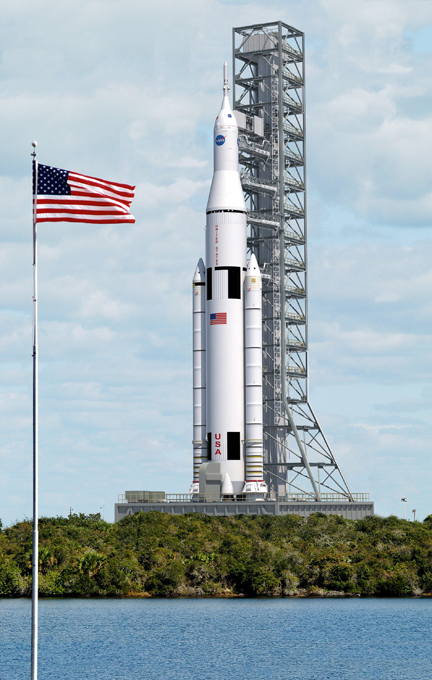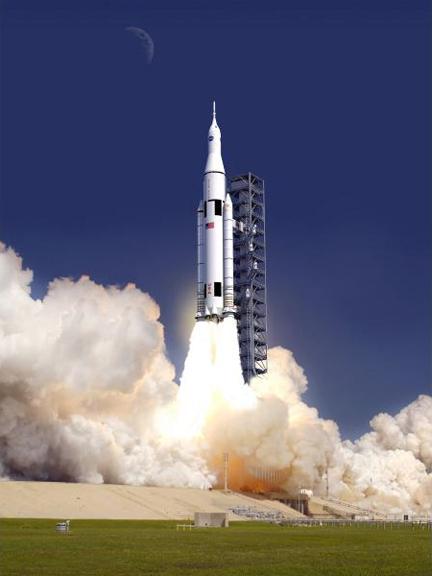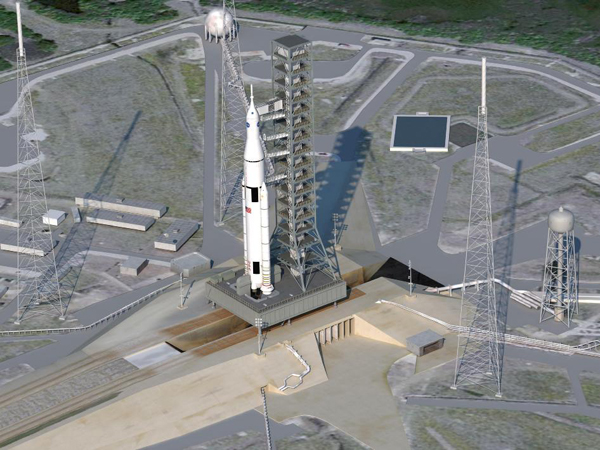NASA unveils new super rocket for manned flights beyond Earth orbit
By WILLIAM HARWOOD
CBS News
NASA unveiled the design of its long-awaited post-shuttle super rocket Wednesday, a gargantuan Saturn 5-class booster intended to propel the agency's manned Orion crew capsules beyond low-Earth orbit and onto a variety of deep space destinations ranging from nearby asteroids to Mars.
If fully funded and developed, it will be the most powerful rocket ever built, dwarfing the lift capability of the space shuttle and exceeding that of the mighty Saturn 5 that propelled the Apollo missions to the moon.
"This launch system will create good-paying American jobs, ensure continued U.S. leadership in space and inspire millions around the world," NASA Administrator Charles Bolden said in a statement. "President Obama challenged us to be bold and dream big, and that's exactly what we are doing at NASA. While I was proud to fly on the space shuttle, tomorrow's explorers will now dream of one day walking on Mars."
The initial version of the heavy-lift rocket will feature two five-segment shuttle-derived solid-fuel boosters strapped to a 27.5-foot-wide first stage powered by three RS-25D/E shuttle main engines. The second stage will use an upgraded Apollo J-2X engine, giving the Space Launch System -- SLS -- rocket the ability to lift 154,000 pounds of payload with a first stage thrust of 8.25 million pounds.
An upgraded version equipped with five shuttle main engines will have a liftoff thrust of some 9 million pounds and be able to lift more than 130 metric tons, or 286,000 pounds, to low-Earth orbit.
For comparison, the Saturn 5 rockets that powered the Apollo moon program stood 363 feet tall, generated 7.5 million pounds of first-stage thrust and were capable of boosting 263,000 pounds of payload to low-Earth orbit. The space shuttle, not counting its own weight, could carry a maximum payload of about 50,000 pounds.
Bill Gerstenmaier, NASA's chief of space operations, said NASA plans one or two unmanned test flights, the first in 2017, using five-segment solid-fuel strap on boosters built by Alliant Techsystems Inc., builder of the shuttle's four-segment boosters and the bigger five-segment rockets intended for the now-canceled Constellation moon program.
But the agency plans to quickly open a competition for follow-on boosters and the first stage core will be designed to accommodate either liquid or solid-fuel strap-ons.
Based on internal and external audits, NASA believes the Space Launch System -- the new heavy lift rocket, the Orion crew capsule and upgrades to the Kennedy Space Center launch infrastructure -- will cost about $3 billion per year, or $18 billion through the first test flight in 2017.
NASA had been spending $2 billion to $3 billion a year on shuttle operations alone and Gerstenmaier said the SLS program will be covered in NASA's current budget profile. But it's not yet clear whether cuts in other areas will be required.
And Gerstenmaier would not speculate on long-term operational costs, saying the agency needed to first define what sort of missions will be flown and when they will be launched.
Candidate missions include flights to nearby asteroids in the 2020s and eventual voyages to orbit and possibly land on Mars in the 2030s. Closer to home, Gerstenmaier said, the rockets could be used to send astronauts on satellite service calls to geosynchronous orbit 22,300 miles up or even to the Lagrangian points, scientifically useful gravitational eddies located a million miles or so from Earth.
"We need to get some more details on the actual rocket performance, put that together with these concepts and then start talking to some people about specifics," he said. "But what we've been tasked to do is build a capability driven framework and that's what we basically have here. We have the first two key elements that are critical to us doing these activities and we'll be working that over the next year or so to define various options."
In the wake of the 2003 Columbia disaster, President Bush ordered NASA to finish the International Space Station and retire the space shuttle by the end of fiscal 2010. When all was said and done, the final three shuttle missions were launched earlier this year and the program officially ended on Aug. 31.
The Bush administration's plan was to eliminate the costly shuttle program -- and the thousands of contractor jobs that made it so expensive -- and use the savings to help pay for a new program, building safer, lower-cost rockets needed to support the establishment of Antarctica-style bases on the moon by around 2020.
But the Bush administration never fully funded the Constellation moon program and President Obama decided in 2009 that it was too expensive. Instead, the president settled on a controversial new plan that marked a drastic change of course for NASA.
The so-called "flexible path" architecture called for the near-term development of private-sector spaceships to ferry astronauts to and from the space station on a for-profit basis while NASA focused on designing new, more affordable rockets and spacecraft for eventual deep space missions.
The commercial crew development program is now in the second round of contracts, with four companies competing to design manned orbital ferry craft. Initial flights are expected in the 2015 timeframe. In the meantime, U.S. astronauts are hitching rides to the station aboard Russian Soyuz spacecraft.
On the exploration front, NASA managers decided earlier to stick with the Constellation program's Orion crew capsule for deep space missions, renaming it the Multi-Purpose Crew Vehicle, or MPCV.
Obama's initial plan did not set a timetable for development of the heavy-lift rocket needed for deep space exploration, but he ultimately supported bipartisan legislation requiring NASA to start development right away and to have a rocket ready to fly by around 2015. Lawmakers have been clamoring for details and some remain skeptical.
"I am pleased that the Obama administration has finally agreed with Congress that SLS is the only viable option to maintain America's leadership in human space flight," Sen. Richard Shelby, an Alabama Republican whose state is home to NASA's Marshall Space Flight Center.
"However, we have not yet seen the details of this decision," he said in a statement. "Accordingly, I will continue to monitor this situation very closely to see whether the administration implements the 130-metric ton SLS plan as enacted by Congress."
Said Rep. Pete Olson, R-Texas: "While I am pleased that the new system has been announced, it was long past due and I will continue to push this White House to comply with the law of the land and get America back into space."
But Sen. Bill Nelson, a Florida Democrat who was instrumental in getting the SLS legislation approved, said "this is perhaps the biggest thing for space exploration in decades. The goal is to fly humans safely beyond low-Earth orbit and deep into outer space where we can not only survive, but one day also live."
Gerstenmaier said the new rocket was designed to keep costs down by taking advantage of existing shuttle main engines, the J-2X engine being developed for Constellation program, keeping the core booster's diameter the same as the shuttle's external tank to permit use of existing ground equipment and sharing components between the first and second stages.
"The key features of the space Launch System that we're developing is it's going to be an 8.4-meter (27.5-foot-wide) core stage, that's the same diameter as the shuttle tank and that gives us some commonality with equipment down at the Cape and lowers some of our development costs up front," he said.
"It also allows us to use some of the MLP (mobile launch platform) hardware that was developed for the Ares program. So that's a good thing for us. We're going to use shuttle main engines underneath that core tank. We'll be able to put three engines under there initially and potentially at some point grow to five engines, and that give us a varying thrust capability."
As for the side-mounted strap-on boosters, "it's initially solid rocket motors for potentially the first or second test flights and then we'll go compete those boosters and they could be any type of propellant," Gerstenmaier said. "We'll define the interface on the core where the solid rocket motors or the liquid rocket motors attach, we'll compete that in a full-up procurement activity."
He said the design of the rocket, with its reliance on existing technology, tooling and shuttle expertise will help NASA manage costs down the road, ensuring a "sustainable" program that will be less sensitive to the budget woes that ultimately derailed Constellation.
"We've tried to put together a construct that gives us flexibility as we go through the development process," he said. "If we don't get exactly the annual budget we anticipated, we have enough flexibility in the program we can accommodate that. We've also spread some of the development activities out ... so that they're not all stacked up on top of each other and that lowers our risk.
"So I'd say we have a pretty agile ability to keep costs under control. We're going to do our part."
CBS News
NASA unveiled the design of its long-awaited post-shuttle super rocket Wednesday, a gargantuan Saturn 5-class booster intended to propel the agency's manned Orion crew capsules beyond low-Earth orbit and onto a variety of deep space destinations ranging from nearby asteroids to Mars.
 |
| NASA's heavy-lift Space Launch System rocket will be ready for its initial test flight in 2017 if the program is fully funded. (Credit: NASA) |
"This launch system will create good-paying American jobs, ensure continued U.S. leadership in space and inspire millions around the world," NASA Administrator Charles Bolden said in a statement. "President Obama challenged us to be bold and dream big, and that's exactly what we are doing at NASA. While I was proud to fly on the space shuttle, tomorrow's explorers will now dream of one day walking on Mars."
The initial version of the heavy-lift rocket will feature two five-segment shuttle-derived solid-fuel boosters strapped to a 27.5-foot-wide first stage powered by three RS-25D/E shuttle main engines. The second stage will use an upgraded Apollo J-2X engine, giving the Space Launch System -- SLS -- rocket the ability to lift 154,000 pounds of payload with a first stage thrust of 8.25 million pounds.
An upgraded version equipped with five shuttle main engines will have a liftoff thrust of some 9 million pounds and be able to lift more than 130 metric tons, or 286,000 pounds, to low-Earth orbit.
For comparison, the Saturn 5 rockets that powered the Apollo moon program stood 363 feet tall, generated 7.5 million pounds of first-stage thrust and were capable of boosting 263,000 pounds of payload to low-Earth orbit. The space shuttle, not counting its own weight, could carry a maximum payload of about 50,000 pounds.
Bill Gerstenmaier, NASA's chief of space operations, said NASA plans one or two unmanned test flights, the first in 2017, using five-segment solid-fuel strap on boosters built by Alliant Techsystems Inc., builder of the shuttle's four-segment boosters and the bigger five-segment rockets intended for the now-canceled Constellation moon program.
But the agency plans to quickly open a competition for follow-on boosters and the first stage core will be designed to accommodate either liquid or solid-fuel strap-ons.
Based on internal and external audits, NASA believes the Space Launch System -- the new heavy lift rocket, the Orion crew capsule and upgrades to the Kennedy Space Center launch infrastructure -- will cost about $3 billion per year, or $18 billion through the first test flight in 2017.
NASA had been spending $2 billion to $3 billion a year on shuttle operations alone and Gerstenmaier said the SLS program will be covered in NASA's current budget profile. But it's not yet clear whether cuts in other areas will be required.
And Gerstenmaier would not speculate on long-term operational costs, saying the agency needed to first define what sort of missions will be flown and when they will be launched.
Candidate missions include flights to nearby asteroids in the 2020s and eventual voyages to orbit and possibly land on Mars in the 2030s. Closer to home, Gerstenmaier said, the rockets could be used to send astronauts on satellite service calls to geosynchronous orbit 22,300 miles up or even to the Lagrangian points, scientifically useful gravitational eddies located a million miles or so from Earth.
 |
| Powered by two five-segment solid-fuel boosters an up to five shuttle main engines in its first stage, the SLS rocket will be the most powerful ever built. (Credit: NASA) |
In the wake of the 2003 Columbia disaster, President Bush ordered NASA to finish the International Space Station and retire the space shuttle by the end of fiscal 2010. When all was said and done, the final three shuttle missions were launched earlier this year and the program officially ended on Aug. 31.
The Bush administration's plan was to eliminate the costly shuttle program -- and the thousands of contractor jobs that made it so expensive -- and use the savings to help pay for a new program, building safer, lower-cost rockets needed to support the establishment of Antarctica-style bases on the moon by around 2020.
But the Bush administration never fully funded the Constellation moon program and President Obama decided in 2009 that it was too expensive. Instead, the president settled on a controversial new plan that marked a drastic change of course for NASA.
The so-called "flexible path" architecture called for the near-term development of private-sector spaceships to ferry astronauts to and from the space station on a for-profit basis while NASA focused on designing new, more affordable rockets and spacecraft for eventual deep space missions.
The commercial crew development program is now in the second round of contracts, with four companies competing to design manned orbital ferry craft. Initial flights are expected in the 2015 timeframe. In the meantime, U.S. astronauts are hitching rides to the station aboard Russian Soyuz spacecraft.
On the exploration front, NASA managers decided earlier to stick with the Constellation program's Orion crew capsule for deep space missions, renaming it the Multi-Purpose Crew Vehicle, or MPCV.
Obama's initial plan did not set a timetable for development of the heavy-lift rocket needed for deep space exploration, but he ultimately supported bipartisan legislation requiring NASA to start development right away and to have a rocket ready to fly by around 2015. Lawmakers have been clamoring for details and some remain skeptical.
"I am pleased that the Obama administration has finally agreed with Congress that SLS is the only viable option to maintain America's leadership in human space flight," Sen. Richard Shelby, an Alabama Republican whose state is home to NASA's Marshall Space Flight Center.
"However, we have not yet seen the details of this decision," he said in a statement. "Accordingly, I will continue to monitor this situation very closely to see whether the administration implements the 130-metric ton SLS plan as enacted by Congress."
 |
| NASA's heavy-lift Space Launch System rocket at the launch pad. (Credit: NASA) |
Said Rep. Pete Olson, R-Texas: "While I am pleased that the new system has been announced, it was long past due and I will continue to push this White House to comply with the law of the land and get America back into space."
But Sen. Bill Nelson, a Florida Democrat who was instrumental in getting the SLS legislation approved, said "this is perhaps the biggest thing for space exploration in decades. The goal is to fly humans safely beyond low-Earth orbit and deep into outer space where we can not only survive, but one day also live."
Gerstenmaier said the new rocket was designed to keep costs down by taking advantage of existing shuttle main engines, the J-2X engine being developed for Constellation program, keeping the core booster's diameter the same as the shuttle's external tank to permit use of existing ground equipment and sharing components between the first and second stages.
"The key features of the space Launch System that we're developing is it's going to be an 8.4-meter (27.5-foot-wide) core stage, that's the same diameter as the shuttle tank and that gives us some commonality with equipment down at the Cape and lowers some of our development costs up front," he said.
"It also allows us to use some of the MLP (mobile launch platform) hardware that was developed for the Ares program. So that's a good thing for us. We're going to use shuttle main engines underneath that core tank. We'll be able to put three engines under there initially and potentially at some point grow to five engines, and that give us a varying thrust capability."
As for the side-mounted strap-on boosters, "it's initially solid rocket motors for potentially the first or second test flights and then we'll go compete those boosters and they could be any type of propellant," Gerstenmaier said. "We'll define the interface on the core where the solid rocket motors or the liquid rocket motors attach, we'll compete that in a full-up procurement activity."
He said the design of the rocket, with its reliance on existing technology, tooling and shuttle expertise will help NASA manage costs down the road, ensuring a "sustainable" program that will be less sensitive to the budget woes that ultimately derailed Constellation.
"We've tried to put together a construct that gives us flexibility as we go through the development process," he said. "If we don't get exactly the annual budget we anticipated, we have enough flexibility in the program we can accommodate that. We've also spread some of the development activities out ... so that they're not all stacked up on top of each other and that lowers our risk.
"So I'd say we have a pretty agile ability to keep costs under control. We're going to do our part."